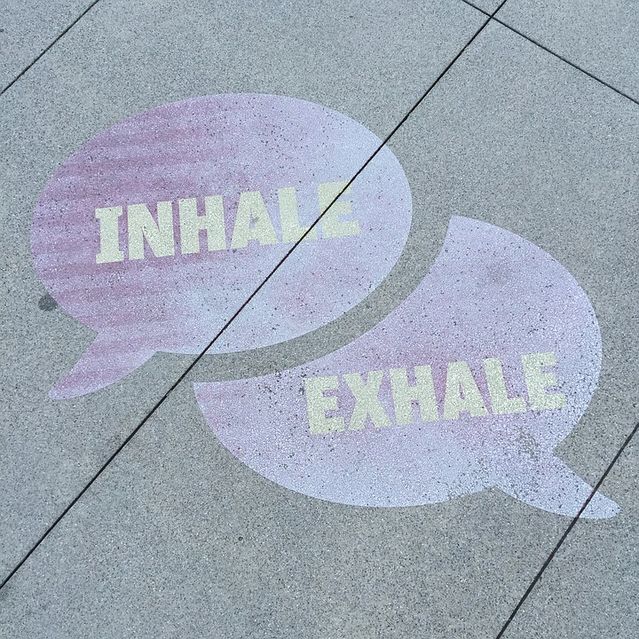Anxiety
The Neural Mechanisms of Anxiety and Shortness of Breath
Neuroscience explains why shortness of breath happens during moments of anxiety.
Posted May 2, 2018
The projector is set up. The chairs are neatly aligned, with water glasses arranged in the center of the table. It’s near-perfect.
In 10 minutes, one of the biggest potential clients your company has ever had is going to walk into the room. As you and your business partner rehearse your pitch one last time, the computer suddenly crashes. You feel paralyzed with a jolt of anxiety as you think to yourself: “There’s no backup file.”
As you begin to hyperventilate, you look over at your partner who is surprisingly calm. He tells you to relax and take a deep breath. While you attempt to slow your breathing, he continues to rehearse. After a few minutes, the computer comes back online. You eventually calm your nerves just in time for the client’s arrival.

Sometimes in life we are placed in demanding situations that feel out of our control. They lead to intense feelings of stress and anxiety. Although each person and each situation is different, very often the best way to handle these negative emotions is to change perspective through body-based techniques. Of these, breathing can be the most effective.
However, what if taking a deep breath wasn’t an option? For people who suffer from dyspnea, the seemingly mundane act of breathing is much more difficult. Dyspnea is characterized as a shortness of breath, and is typically amplified in states of anxiousness. Possible causes include asthma, chronic obstructive pulmonary disorder (COPD), heart failure and psychogenic disorders such as general anxiety disorder (GAD) and depression.
For someone with dyspnea, navigating an anxiety-inducing situation is doubly difficult. The negative cycle of anxiety and shortness of breath is a dangerous one to get caught in.
The neural pathway that affects perception of dyspnea
The degree to which dyspnea patients perceive their shortness of breath to be worse than it is—known as catastrophizing—was the topic of investigation that interested a team of neuroscientists at the University of Hamburg. Specifically, the researchers were curious about the neural basis of dyspnea and its impact on people’s ability to manage stressful situations.
The researchers hypothesized that dyspnea catastrophizing was correlated with a brain region known as the anterior cingulate cortex (ACC). A primary role of the ACC is to process negative affective states such as anxiety. Given this, it was suggested that participants who rated their dyspnea as more severe (i.e., panicked about having shortness of breath) would also experience unusually high levels of activation in the ACC.
In other words, patterns of hyperactivation in the ACC would provide researchers with a brain-based explanation of shortness of breath during anxious states.
The experiment & associated findings
To test their hypothesis, Dr. Cornelia Stoeckel and her team recruited participants between the ages of 20 and 80 who did not have any history of impaired lung function. To induce dyspnea, the participants were instructed to wear a tightly fighting face mask. This mask was connected to a two-way valve which allowed the neuroscientist to alter the severity of dyspnea experienced. They did this while measuring their brain activation patterns with fMRI.
During the experiment, the participants were presented with mild and severe blocks of dyspnea in an alternating order. During each occurrence, their ability to inhale was reduced for 24 seconds. Following each block, the participants were required to rate the intensity and unpleasantness of their experience.
The ratings provided by the participants as well as the fMRI data confirmed the proposed hypothesis: Participants who repeatedly rated their experience as more severe – regardless of the level of dyspnea that was induced – also experienced increased activation in the ACC. These results contradict previous studies which reported that other brain regions such as the amygdala and insula played a fundamental role in dyspnea catastrophizing. Here, it was linked primarily to ACC activation.
Where do we go from here?
The discovery of the ACC’s involvement in the catastrophizing of dyspnea has the potential to improve many lives. Whether it’s a panic attack or an allergic reaction, most people have experienced a shortness of breath at some point in their life. This unsettling experience is magnified when people exaggerate the level of threat they are under, as they convince themselves that they can’t breathe. Anxiety begets greater anxiety. A vicious cycle ensues.

The study here may be the key to solving this dilemma. The results from this experiment allow researchers to put their efforts into learning more about ACC functioning. This will hopefully allow for treatments to be directed towards reducing enhanced activity in this brain region. For example, cognitive reappraisal and other emotion regulation techniques may be particularly useful for people who have a tendency to catastrophize perceptions of dyspnea.
Until then, remember: Just breathe.
References
Stoeckel, M. C., Esser, R. W., Gamer, M., Buchel, C., & Leupoldt, A. (2018). Dyspnea catastrophizing and neural activations during the anticipation and perception of dyspnea. Psychophysiology, 55,.




